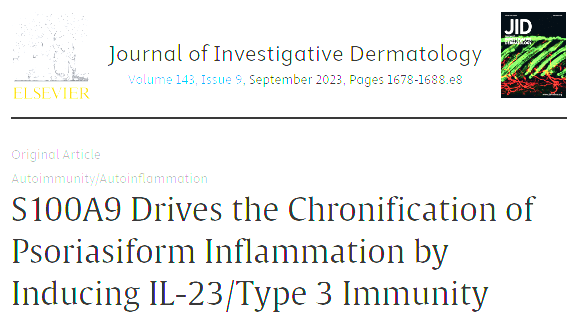S100A9 Drives the Chronification of Psoriasiform Inflammation by Inducing IL-23/Type 3 Immunity
Psoriasis is a chronic inflammatory skin disorder driven by the IL-23/type 3 immune response. However, molecular mechanisms sustaining the chronicity of inflammation and psoriatic lesions remain elusive. Combining systematic analyses of several transcriptomic datasets, we delineated gene signatures across human psoriatic skin, identifying S100A9 as one of the most up-regulated genes, which was confirmed in lesioned skin from patients with psoriasis and preclinical psoriasiform skin inflammation models. Genetic ablation or pharmacologic inhibition of S100A9 alleviated Aldara-induced skin inflammation. By single-cell mapping of human psoriatic skin and bone marrow chimeric mice experiments, we identified keratinocytes as the major source of S100A9. Mechanistically, S100A9 induced IL-23 production by dendritic cells, driving the IL-23/type 3 immunity in psoriasiform skin inflammation. In addition, the cutaneous IL-23/IL-17 axis induced epidermal S100A9 expression in human and experimental psoriasis. Thus, we showed an autoregulatory circuit between keratinocyte-derived S100A9 and IL-23/type 3 immunity during psoriasiform inflammation, identifying a crucial function of S100A9 in the chronification of psoriasis
Authors
Silva de Melo BM, Veras FP, Zwicky P, et al.
External link
Publication Year
Publication Journal
Associeted Project
Microbiology or Immunology
Lista de serviços
-
RASL11A, member of a novel small monomeric GTPase gene family, is down-regulated in prostate tumors.RASL11A, member of a novel small monomeric GTPase gene family, is down-regulated in prostate tumors.
-
Splice variants of TLE family genes and up-regulation of a TLE3 isoform in prostate tumors.Splice variants of TLE family genes and up-regulation of a TLE3 isoform in prostate tumors.
-
Concepts on Microarray Design for Genome and Transcriptome AnalysesConcepts on Microarray Design for Genome and Transcriptome Analyses
-
The iron stimulon of Xylella fastidiosa includes genes for type IV pilus and colicin V-like bacteriocins.The iron stimulon of Xylella fastidiosa includes genes for type IV pilus and colicin V-like bacteriocins.
-
Origins of the Xylella fastidiosa prophage-like regions and their impact in genome differentiation.Origins of the Xylella fastidiosa prophage-like regions and their impact in genome differentiation.
-
The role of prophage in plant-pathogenic bacteria.The role of prophage in plant-pathogenic bacteria.
-
Genetic control of immune response and susceptibility to infectious diseases.Genetic control of immune response and susceptibility to infectious diseases.
-
Building capacity for advances in tuberculosis research; proceedings of the third RePORT international meeting.Building capacity for advances in tuberculosis research; proceedings of the third RePORT international meeting.
-
São Paulo School of Advanced Sciences on Vaccines: an overview.São Paulo School of Advanced Sciences on Vaccines: an overview.
-
A reasonable request for true data sharing.A reasonable request for true data sharing.

